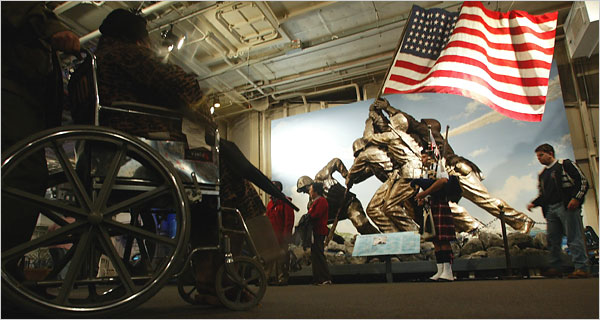Yesterday’s New York Times reports that “Iwo Jima Sculpture, Model for Marine War Memorial, Is Losing Its Home on Floating Museum.” The story is about a statue created as one of the models for the Marine Memorial at Arlington Cemetery. Since 1995 it has been part of the Sea, Air, and Space Museum on the aircraft carrier Intrepid. Museum officials have decided that the statue has no place in a renovation now underway. Other items have been shipped out to other museums, but there are no takers for the statue.
Is the Iwo Jima icon being consigned to the back lot of US public culture, or, worse, the scrap heap of history? Could happen, of course. Photographic icons are not immortal and many have strong generational resonance. Ken Burns has remarked that his forthcoming documentary on The War reflects his sense of urgency about recording soon-to-be-lost oral testimony. Perhaps he also sensed that his primary audience was slipping away as well.
The photo accompanying the story reflects some of these tensions.
The flagraising dominates the middle of the frame but also is set back as if receding into blue (heavenly) sky beyond and then into the vanishing point of the picture. The lighting, faux bronze hues of the men, and bright flag give the sculpture a heroic cast, but it also looks colorized in comparison with the rest of the picture and, more important, with the iconic photograph that was the inspiration for the statue. The effect seems contrived, as if to evoke reverence that already has faded, or to appeal to a younger audience that already has too many flashier distractions.
This sense of futility is reflected in the other figures in the picture. On the far right, we see a young man; if he isn’t old enough to be drafted, he soon will be. He is the natural successor to those memorialized by the statue, whose civic republican aesthetic carries with it the anxiety that the sacrifices of one generation will be squandered by those who follow. This is the visitor who should be gazing reverently up at the model of civic virtue. Instead, he isn’t looking at the statue, and he seems to be either fixated on the kilted bagpiper in front of him or hurrying by as if intent on getting to something more pressing such as the cafeteria. The piper, who is hard to pick out of the background figures, seems to be another contrivance, and his Scottish costume suggests that the whole tableau is one of pastiche. Other figures continuing leftward around the statue also are looking away. The only person looking at the flag raising is the woman in the wheelchair that dominates the left foreground. Indeed, she is the counterpoint to the statue: both sit in metal, and her umbrella points directly to the base of the flagpole. Thus, the one connection being made in the picture is between able-bodied men in the past and a disabled woman in the present. This does not bode well for the statue.
The full implication might be that times have changed and different people are dealing with different issues. We need national solidarity and heroic effort not on the battlefield but in health care reform. We need museums, too, of course, and we may still have good use of the Iwo Jima icon. What we don’t need, however, is to keep one of several poorly crafted statues in the public eye. Today, as in 1944, the public art that counts is photojournalism.
Photograph by Librado Romero/The New York Times.

Discussion